The Effect of Population Density on Morpho-Ecological Characteristics of the Rare Species Pontechium maculatum (Boraginaceae) in “Iron Gates” Natural Park (Romania)
Abstract
1. Introduction
2. Materials and Methods
2.1. Area of Study
2.2. Floristic and Phytosociological Analysis
2.3. Morphological and Physiological Determinations
2.4. Statistical Analysis
3. Results
3.1. Phytosociological Assessment of Pontechium maculatum in Plant Communities
3.2. Morphological and Physiological Analysis
3.3. Multivariate Analysis of the Results
4. Discussion
5. Conclusions
Author Contributions
Funding
Institutional Review Board Statement
Informed Consent Statement
Data Availability Statement
Conflicts of Interest
References
- Nowak, B.; Sitek, E.; Augustynowicz, J. Sourcing and Propagation of Pontechium maculatum for Horticulture and Species Restoration. Biology 2020, 9, 317. [Google Scholar] [CrossRef]
- Hilger, H.H.; Böhle, U.R. Pontechium: A new genus distinct from Echium and Lobostemon (Boraginaceae). Taxon 2000, 49, 737–746. [Google Scholar] [CrossRef]
- Goriup, P.; Anastasiu, P.; Barbos, M.; Nicolin, A.; Niculescu, M.; Oprea, A. Natura 2000 in Romania Species Fact Sheets; Romanian Ministry of Environment and Sustainable Development: Bucharest, Romania, 2008.
- Dresler, S.; Kubrak, T.; Bogucka-Kocka, A.; Szymczak, G. Determination of Shikonin and Rosmarinic Acid in Echium vulgare L. and Echium russicum J.F. Gmel. by Capillary Electrophoresis. J. Liq. Chromatogr. Relat. Technol. 2015, 38, 698–701. [Google Scholar] [CrossRef]
- Olennikov, D.N.; Daironas, Z.V.; Zilfikarov, I.N. Shikonin and Rosmarinic-Acid Derivatives from Echium russicum Roots. Chem. Nat. Compd. 2017, 53, 953–955. [Google Scholar] [CrossRef]
- Guil-Guerrero, J.L.; García-Maroto, F.; Vilches-Ferrón, M.A.; López-Alonso, D. Gamma-linolenic acid from fourteen Boraginaceae species. Ind. Crop. Prod. 2003, 18, 85–89. [Google Scholar] [CrossRef]
- Holub, J.; Procházka, F. Red List of vascular plants of the Czech Republic—2000. Preslia 2000, 72, 187–230. [Google Scholar]
- Chmielewski, P.; Czarnecka, B.; Kucharczyk, M. Echium russicum J.F.Gmel. In Polish Plant Red Data Book; Pteridophyta and Spermatophyta; Akademia Nauk: Kraków, Poland, 2014; pp. 417–418. [Google Scholar]
- Turis, P.; Kliment, J.; Feráková, V.; Dítě, D.; Eliáš, P.; Hrivnák, R.; Košťál, J.; Šuvada, R.; Mráz, P.; Bernátová, D. Red List of vascular plants of the Carpathian part of Slovakia. Thaiszia J. Bot. 2014, 24, 35–87. [Google Scholar]
- Petrova, A.; Vladimirov, V. Red List of Bulgarian vascular plants. Phytol. Balc. 2009, 15, 63–94. [Google Scholar]
- EU Habitats Directive. Council Directive 92/43/EEC of 21 May 1992 on the Conservation of Natural Habitats and of Wild Fauna and Flora—Consolidated Version 01/01/2007. (as Modified by Directive 2013/17/EU). 1992. Available online: https://environment.ec.europa.eu/topics/nature-and-biodiversity/habitats-directive_en (accessed on 27 June 2025).
- Sava, A.R.; Boz, I.; Costică, N. Contribution to the knowledge of vegetative organs structure at Echium russicum J.F. GMELIN. Analele Ştiinţifice Univ. “Al. I. Cuza” Iaşi II Biol. Veg. 2019, 65, 44–54. [Google Scholar]
- Chirilă, S.D.; Vassilev, K. Habitat preference for the populations of the endangered species Pontechium maculatum (Boraginaceae) in Romania. Tuexenia 2024, 44, 131–157. [Google Scholar] [CrossRef]
- Mountford, O.; Gafta, D.; Anastasiu, P.; Bărbos, M.; Nicolin, A.; Niculescu, M.; Oprea, A. Natura 2000 in Romania; Habitat Fact Sheets; Ministry of Environment and Sustainable Development: Bucharest, Romania, 2008; pp. 252, 502.
- Prodan, I. Aspecte din vegetația zonei de vest a R.P.R. Bul. Șt. Acad. Rom. Biol. Șt. Agr. București 1956, 8, 5–45. [Google Scholar]
- Borza, A. Cercetări asupra florei și vegetației din Câmpia Română. Contrib. Bot. Cluj Napoca 1968, 2, 149–183. [Google Scholar]
- Ciocârlan, V. Flora Ilustrată a României, Pteridophyta et Spermatophyta, 2nd ed.; Edit. Ceres: Bucharest, Romania, 2000; Volume 2, 1138p. [Google Scholar]
- Ciocârlan, V. Flora ilustrată a României, Pteridophyta et Cormophyta; Ed. Ceres: Bucharest, Romania, 2009. [Google Scholar]
- Mititelu, D.; Chifu, T. Flora și vegetația județului Botoșani. Stud. Comun. Muz. Ști. Naț. Bacău 1993, 13, 109–126. [Google Scholar]
- Oprea, A. Lista Critică a Plantelor Vasculare din România; Editura Universitatii A.I. Cuza: Iasi, Romania, 2005; 668p. [Google Scholar]
- Oprea, A. Flora și Vegetația Câmpiei Tecuciului; Editura Universitatii A.I. Cuza: Iasi, Romania, 2021; 596p. [Google Scholar]
- Grințescu, I. Echium L. In Flora Republicii Populare Romîne; Săvulescu, T., Ed.; Academia Republicii Populare: Bucharest, Romania, 1960; Volume VII, pp. 230–237. [Google Scholar]
- Popescu, I.E. The reservation of centuries-old hay from Valea lui David Iaşi. In Miroslava Commune. About Places and People; Susai, Ș., Ed.; Masterprint: Iasi, Romania, 2013; pp. 169–186. [Google Scholar]
- Sârbu, I.; Ștefan, N.; Oprea, A. Vascular Plants from Romania—Illustrated Field Determinant; Victor B Victor: Bucharest, Romania, 2013; 1320p. [Google Scholar]
- Available online: https://www.europarl.europa.eu/portal/en (accessed on 9 October 2024).
- Gafta, D.; Mountford, J.O. (Eds.) Manual de Interpretare a Habitatelor Natura 2000 din România; Editura Risoprint: Cluj-Napoca, Romania, 2008. [Google Scholar]
- Rozylowicz, L.; Nita, A.; Manolache, S.; Popescu, V.D.; Hartel, T. Navigating protected areas networks for improving diffusion of conservation practices. J. Environ. Manag. 2019, 230, 413–421. [Google Scholar] [CrossRef]
- Săvulescu, T. (Ed.) Flora R.P Române. R.S România, 1-XIII; Editura Academiei Romane: Bucharest, Romania, 1952–1976. [Google Scholar]
- Tutin, T.G.; Heywood, V.H.; Burges, N.A.; Moore, D.M.; Valentine, D.H.; Walters, C.M.; Webb, D.A. (Eds.) Flora Europaea, 2nd ed.; Cambridge University Press: Cambridge, UK, 1964–1980 & 1993; Volume 1–5. [Google Scholar]
- Braun-Blanquet, J. Plantsociology. In The Study of Plant Communities; Fullerand, G.D.; Conrad, H.S., Translators; McGraw-Hill: New York, NY, USA, 1932; 539p. [Google Scholar]
- Coldea, G. Prodrome des associations végétales des Carpates du sud-est (Carpates Roumaines). Doc. Phytosociol. 1991, 13, 317–539. [Google Scholar]
- Sanda, V.; Popescu, A.; Barabaş, N. Cenotaxonomia şi caracterizarea grupărilor vegetale din România. In Studii şi Comunicări Biologie Vegetală; Edit. “I. Borcea”: Bacău, Romania, 1998; 342p. [Google Scholar]
- Sanda, V.; Popescu, A.; Stancu, D.I. Structura Cenotica si Caracterizarea Ecologica a Fitocenozelor din România; Editura Cophis: Pitesti, Romania, 2001. [Google Scholar]
- Oberdorfer, E. Teil IV: Wälder und Gebüsche 2. In Süddeutsche Pflanzen—Gesellschaften; Stark berabeilete Auflage Texband; Gustav Fischer: Jena, Germany, 1992. [Google Scholar]
- Mucina, L.; Grabherr, G.; Ellmauer, T.; Wallnöfer, B. (Eds.) Die Pflanzengesellschaften Österreichs; Band I–III; G. Fischer: Jena, Germany, 1993. [Google Scholar]
- Mucina, L.; Bültmann, H.; Dierßen, K.; Theurillat, J.P.; Raus, T.; Tichý, L. Vegetation of Europe: Hierarchical floristic classification system of vascular plant, bryophyte, lichen, and algal communities. Appl. Veg. Sci. 2016, 19, 3–264. [Google Scholar] [CrossRef]
- Rodwell, J.S.; Schaminée, J.H.J.; Mucina, L.; Pignatti, S.; Dring Moss, J.D. The Diversity of European Vegetation—An Overview of Phyto-Sociological Alliances and Their Relationships to EUNIS Habitats; [report no. EC-LNV 2002(054)]; National Reference Centre for Agriculture, Nature and Fisheries: Wageningen, The Netherlands, 2002; p. 109.
- Harman, H.H. Modern Factor Analysis, 3rd ed.; University of Chicago Press: Chicago, IL, USA, 1976; p. 376. [Google Scholar]
- Sharma, S. Applied Multivariate Techniques, 1st ed.; John Wiley and Sons: New York, NY, USA, 1996; 493p. [Google Scholar]
- Stugren, B. Bazele Ecologiei Generale; Ed. Ştiinţă şi Enciclopedică: Bucureşti, România, 1982; 435p. [Google Scholar]
- Tofan, D.E.; Ionita, O.; Ghendov, V. In situ and ex situ conservation of Ponthechium maculatum (L.) Böhle et Hilger (Boraginaceae) in Republic of Moldova. AGROFOR Int. J. 2024, 9, 69–76. [Google Scholar]
- Gheorghe, I.F.; Memedemin, D.; Graza, A.A. Important Species of Plants for Biodiversity Conservation in the North Dobrogean Plateau—Conservation Status. In Proceedings of the Delta Dunării VIII, Tulcea, Romania, 12–17 May 2020; pp. 47–62. Available online: https://biblioteca-digitala.ro/reviste/Delta-Dunarii/Revista-Delta-Dunarii-08-2020_05.pdf (accessed on 9 October 2024).
- Zaldea, G.; Nechita, A.; Damian, D.; Ghiur, A.D.; Cotea, V.V. Climate changes in recent decades, the evolution of the drought phenomenon and their influence on vineyards in north-eastern Romania. Not. Bot. Horti Agrobot. Cluj Napoca 2021, 49, 12448. [Google Scholar] [CrossRef]
- Working Group on Fighting Climate Change: An Integrated Approach. In Executive Summary of the Report Limiting Climate Change and Its Impact: An Integrated Approach for Romania; English Translation; Presidential Administration of Romania, Department of Climate and Sustainability: Bucharest, Romania, 2023.
- Available online: https://climate-adapt.eea.europa.eu/ (accessed on 9 October 2024).
- Chaudhary, V.; Oli, M.K. A critical appraisal of population viability analysis. Conserv. Biol. 2020, 34, 26–40. [Google Scholar] [CrossRef] [PubMed]
- Iriondo, J.M. The survey and modelling of small plant populations as a basis for developing conservation strategies. Bocconea 1996, 5, 151–157. [Google Scholar]
- Gauthier, P.; Pons, V.; Letourneau, A.; Klesczewski, M.; Papuga, G.; Thompson, J.D. Combining population monitoring with habitat vulnerability to assess conservation status in populations of rare and endangered plants. J. Nat. Conserv. 2017, 37, 83–95. [Google Scholar] [CrossRef]
- Kaya, O.F.; Ertekin, A.S. Evaluation of the taxonomy and conservation status of Podonosma sintenisii (Boraginaceae). Botanica 2024, 30, 31–41. [Google Scholar] [CrossRef]
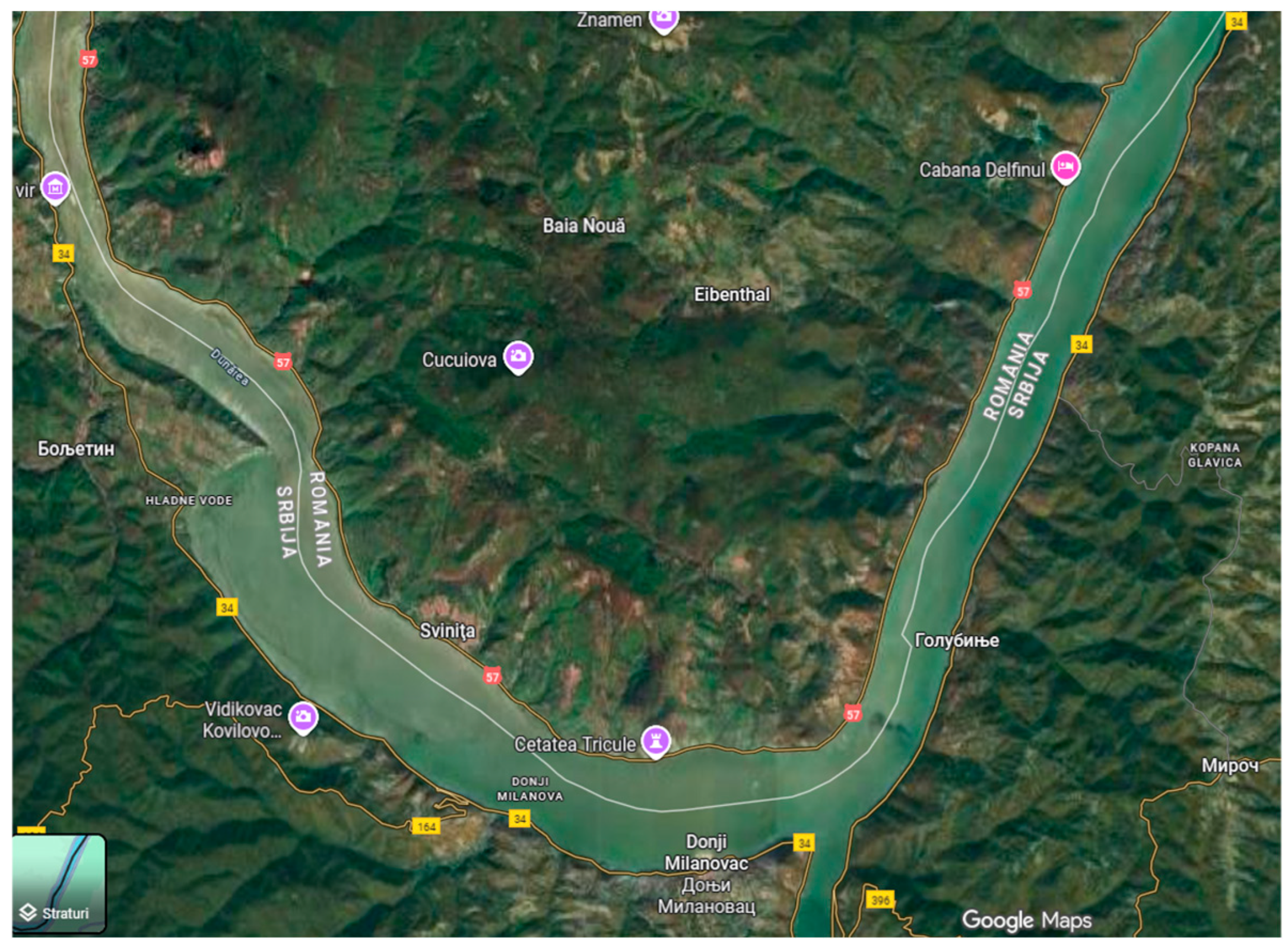
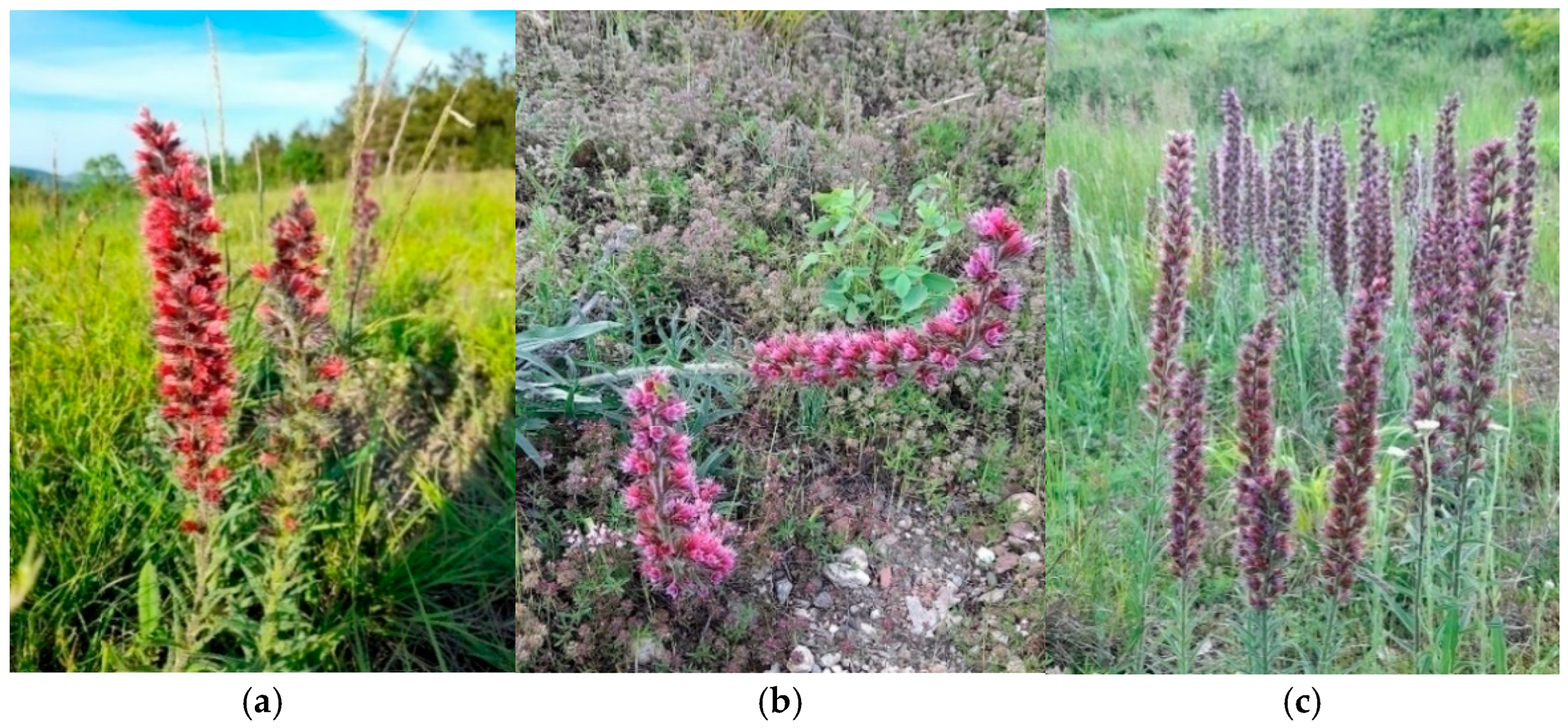
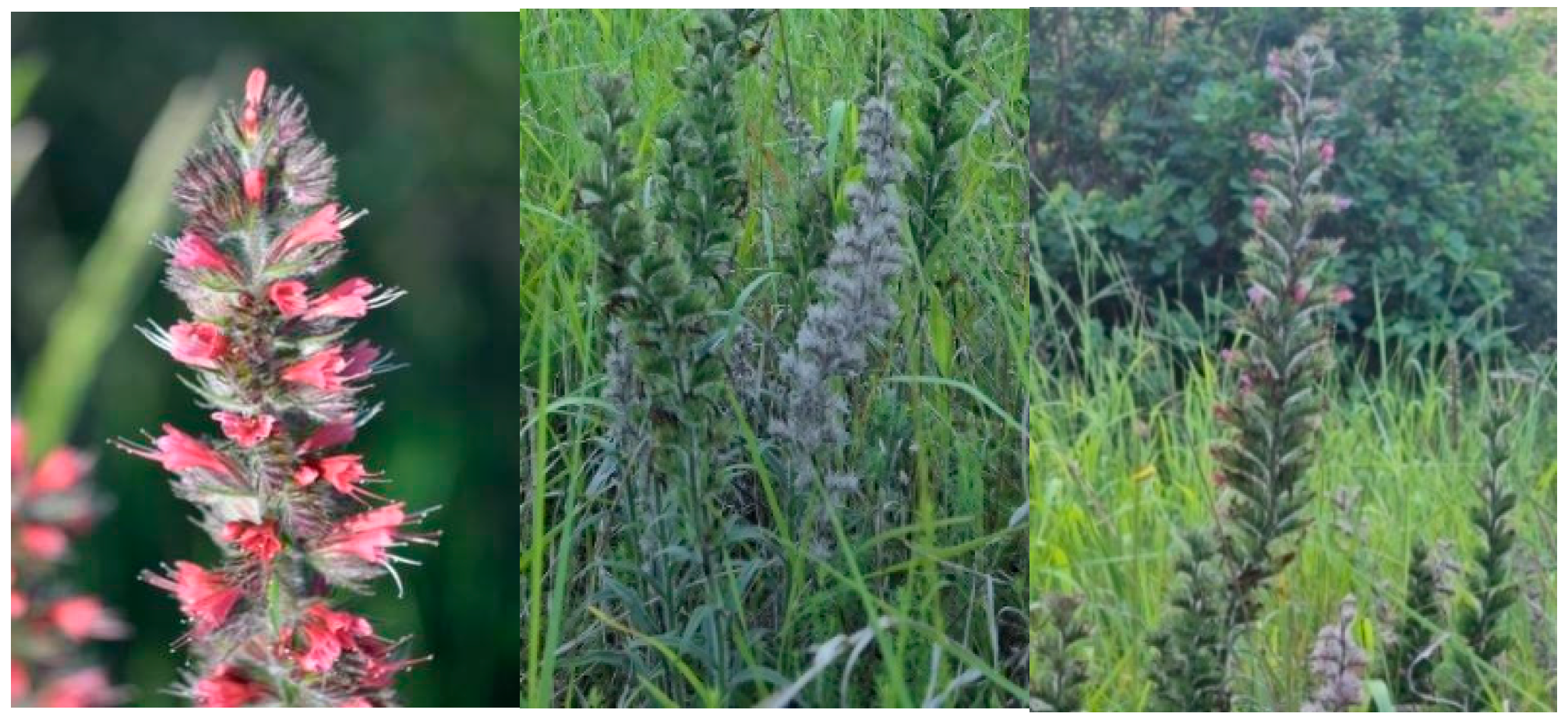

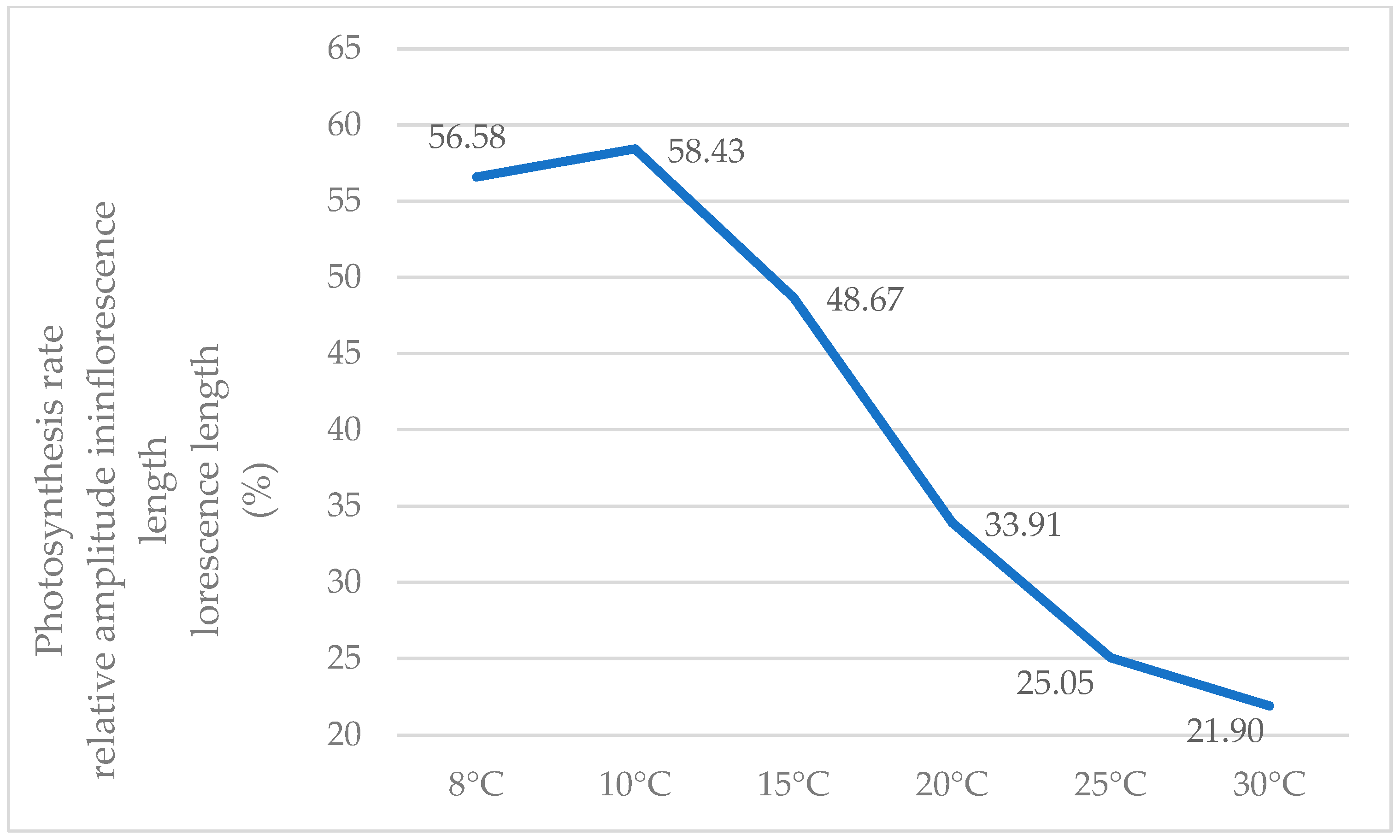
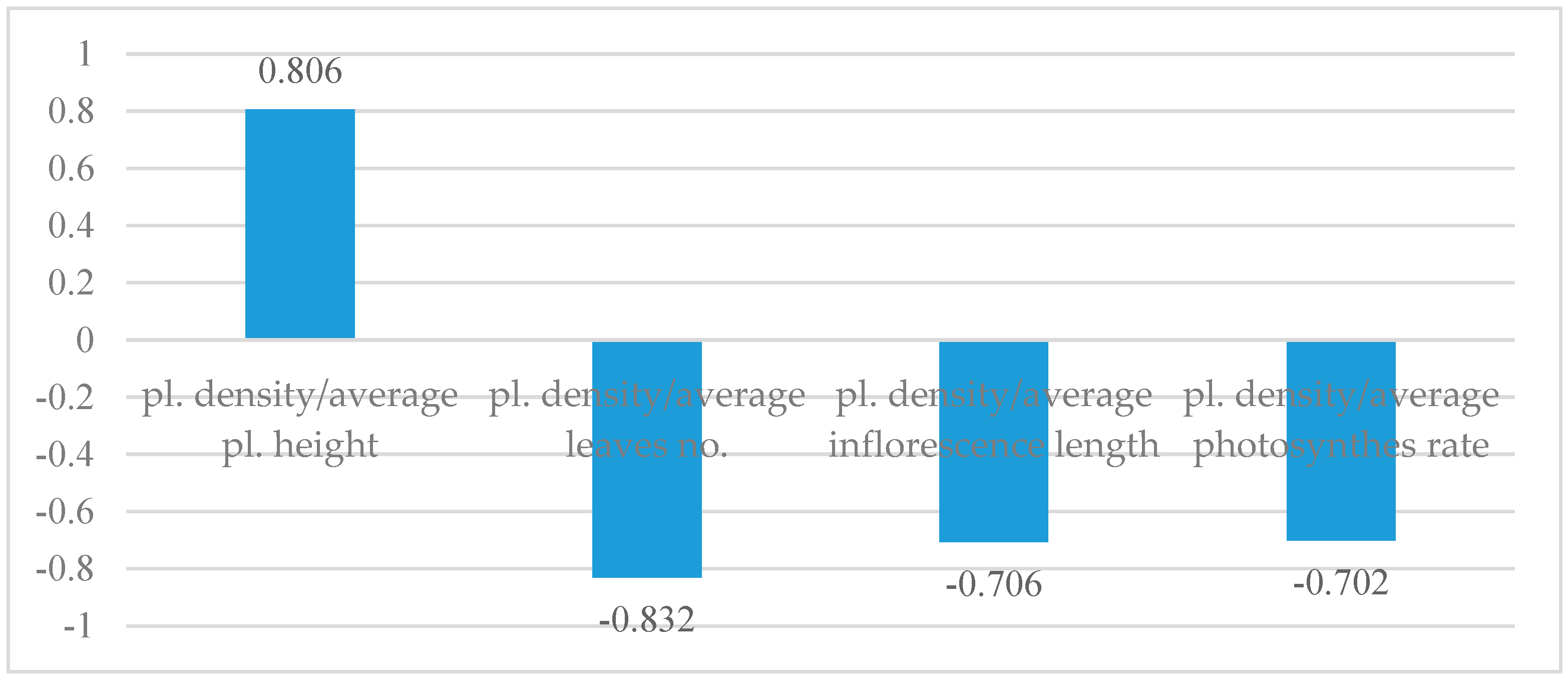
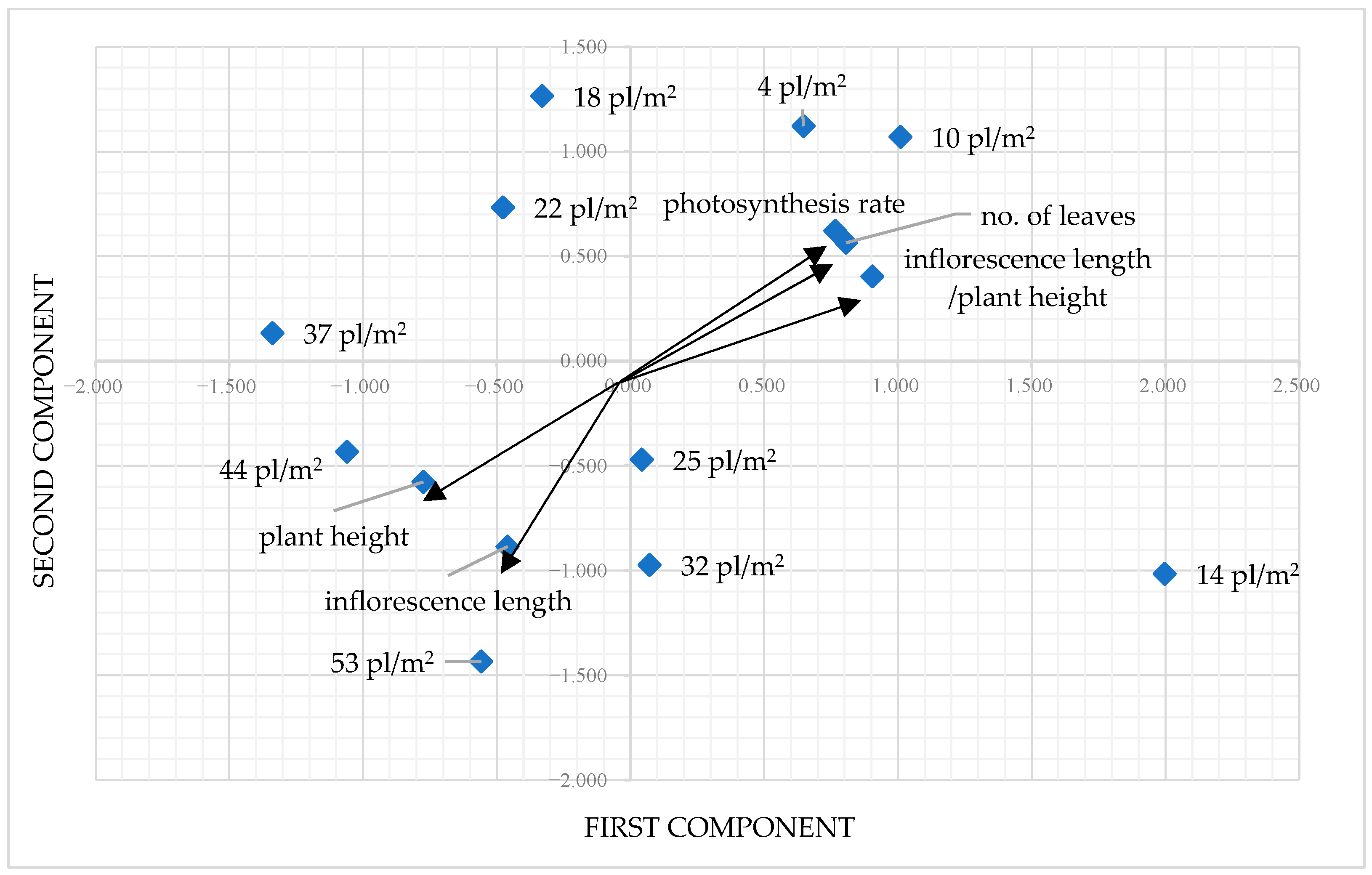
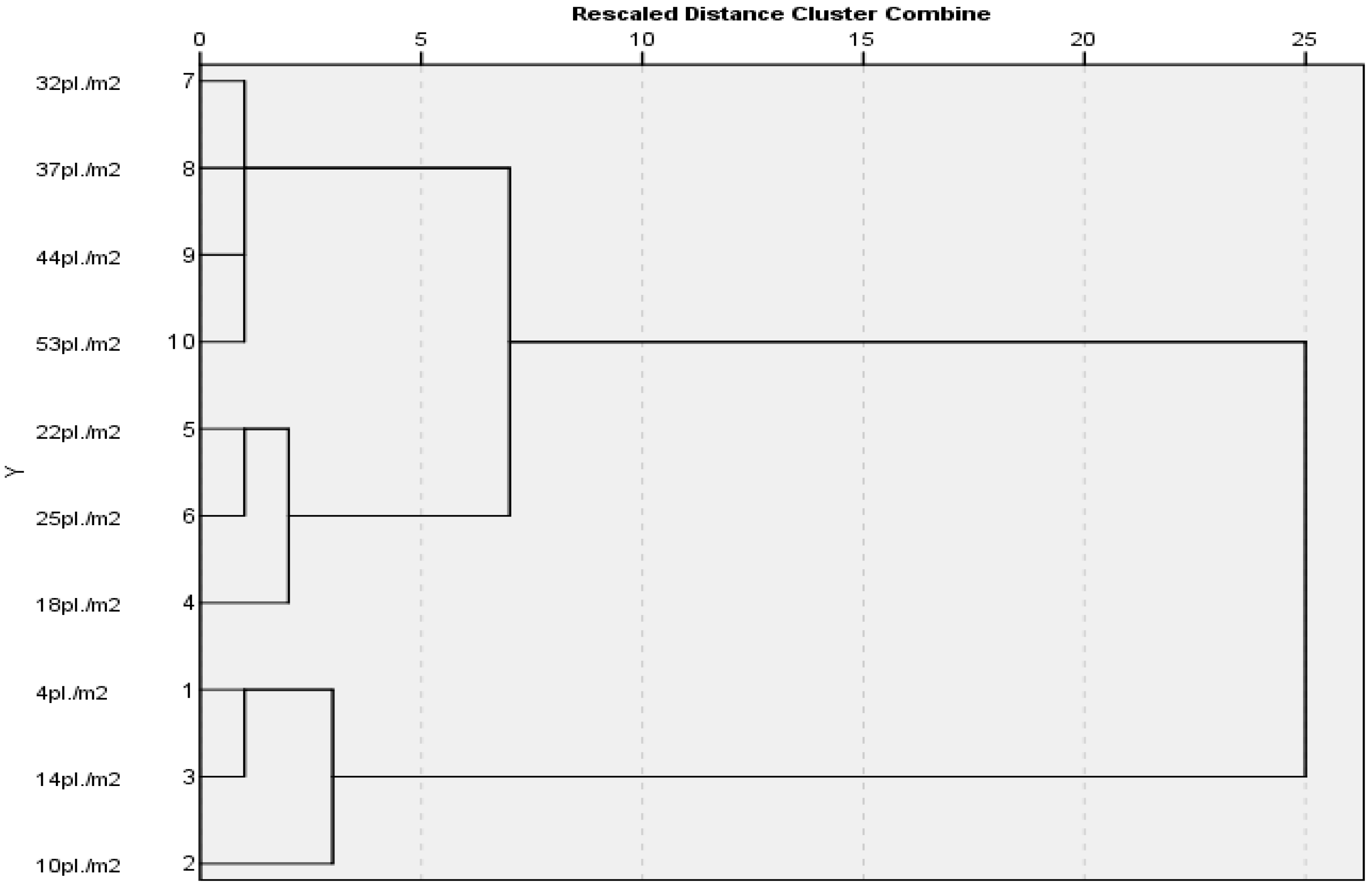
| Plant Community No. | 1 | 2 | 3 | 4 |
|---|---|---|---|---|
| Area (m2) | 100 | 100 | 100 | 100 |
| Number of relevées analyzed | 5 | 5 | 5 | 5 |
| Species characteristics | Constancy of the species (K) | |||
| Brachypodium pinatum | V | . | . | . |
| Chrysopogon gryllus | V | V | . | V |
| Danthonia alpina | I | . | IV | . |
| Festuca rupicola | II | V | II | V |
| Festuca valesiaca | II | V | I | V |
| Medicago falcata | . | . | III | I |
| Medicago lupulina | . | I | III | . |
| Medicago minima | I | IV | I | I |
| Thymus pannonicus | II | IV | V | III |
| Festucion valesiacae et Festucetalia valesiacae | ||||
| Fragaria viridis | . | II | . | . |
| Achillea coarctata | . | II | . | . |
| Achillea setacea | . | . | IV | . |
| Allium favum | . | . | I | I |
| Anthemis tinctoria | I | . | III | I |
| Bromuss quarrosus | . | . | II | . |
| Carlina vulgaris | V | II | . | II |
| Chondrilla juncea | . | . | I | . |
| Pontechium maculatum | III | V | II | V |
| Falcaria vulgaris | . | . | III | . |
| Koeleria macranta | . | . | I | . |
| Knautia arvensis | . | I | . | . |
| Muscari tenuiflorum | . | I | I | I |
| Potentilla arenaria | . | . | II | . |
| Scabiosa banatica | . | . | III | . |
| Teucrium chamaedrys | IV | V | III | V |
| Festuco-Brometea | ||||
| Galium verum | V | . | II | V |
| Ajuga genevensis | V | V | . | I |
| Allium vineale | . | I | III | . |
| Centaurea atropurpurea | ||||
| Cerastium brachypetalum | . | III | . | . |
| Cerastium glomeratum | V | I | . | II |
| Coronilla varia | I | . | III | II |
| Danthonia provincialis | IV | III | . | . |
| Dianthus armeria | II | . | I | II |
| Dianthus giganteus ssp. banaticus | II | . | . | II |
| Draba verna | I | III | . | IV |
| Eryngium campestre | IV | IV | I | I |
| Euphorbia cyparissias | I | I | III | I |
| Hieracium pilosella | V | V | . | I |
| Hypericum perforatum | I | I | . | III |
| Ornithgalum umbellatum | I | I | . | I |
| Polygala comosa | . | . | II | I |
| Potentilla argentea | V | V | . | I |
| Prunella laciniata | I | . | . | . |
| Ranunculus sardous | . | . | II | I |
| Rhinanthus rumelicus | . | . | II | I |
| Rorippa austriaca | . | . | I | I |
| Salvia nemorosa | . | . | I | . |
| Salvia verticilillata | . | . | III | . |
| Cleistogenes serotina | I | . | . | . |
| Tragopogon dubius | . | . | III | I |
| Trifolium campestre | IV | IV | . | I |
| Veronica prostrata | I | I | . | . |
| Molinio-Arrhenatheretea | ||||
| Achillea millefolium | IV | III | . | III |
| Agrostis capillaris | IV | V | I | III |
| Alopecurus pratensis | V | . | . | III |
| Anacamptis papilionacea | IV | . | . | IV |
| Anacamptis pyramidalis | II | I | . | II |
| Anchusa barellieri | . | . | . | III |
| Anchusa officinalis | I | . | . | I |
| Anthoxanthum odoratum | II | II | I | II |
| Briza media | IV | . | . | II |
| Campanula patula ssp. patula | V | II | . | II |
| Centaurea solstitialis | I | . | . | . |
| Cerastium brachypetalum | V | V | . | III |
| Cerastium glomeratum | V | V | . | I |
| Cichorium intybus | I | I | . | . |
| Cynosurus cristatus | . | I | . | . |
| Cynosurus echinatus | . | II | . | . |
| Dactylis glomerata | II | I | I | II |
| Dasypyrum villosum | . | . | I | . |
| Dianthus carthusianorum | . | . | V | . |
| Dorycnium herbaceum | . | . | I | . |
| Filipendula hexapetala | . | . | I | . |
| Holcus lanatus | . | . | I | . |
| Hypericum rocheli | . | . | I | II |
| Hypochoeris maculata | . | . | I | . |
| Inula britannica | . | . | I | . |
| Leontondon hispidus | . | . | II | . |
| Leucanthemum vulgare | . | . | I | . |
| Melica ciliata | . | . | IV | I |
| Orchis morio | II | . | II | . |
| Orchis militaris | I | . | I | . |
| Orchis coriophora | I | . | . | . |
| Orobanche gracillis | . | . | I | . |
| Peucedanum cervaria | . | . | II | . |
| Phleum montanum | . | . | I | . |
| Phleum phleoides | . | . | I | I |
| Plantago lanceolata | . | . | II | I |
| Plantago media | . | . | I | . |
| Poa pratensis | . | . | III | . |
| Ranunculus illyricus | I | . | III | . |
| Rumex acetosa | . | I | I | I |
| Rumex crispus | . | . | III | . |
| Sanguisorba minor | . | . | II | . |
| Sideritis montana | . | . | II | I |
| Sisymbrium officinale | . | . | I | . |
| Trifolium montanum | . | . | II | . |
| Trifolium pratense | I | II | I | I |
| Trifolium repens | . | . | II | . |
| Trifolium resupinatum | I | . | I | I |
| Vicia cracca | . | . | I | . |
| Viola tricolor | I | II | I | . |
| Vulpia myuros | . | . | III | I |
| Stellarietea mediae | ||||
| Carduus candicans | V | II | . | II |
| Carthamus lanatus | III | II | . | II |
| Conyza canadensis | II | II | II | II |
| Cynodon dactylon | . | III | . | . |
| Erigeron annuus | III | . | I | . |
| Erodium cicutarium | . | I | . | . |
| Gagea arvensis | . | . | I | . |
| Hyoscyamus niger | . | . | I | . |
| Papaver dubium | IV | IV | . | I |
| Sisymbrium loeselli | I | I | . | . |
| Thlaspi arvense | I | I | . | . |
| Xantium orientale | IV | II | III | I |
| Variae Syntaxa | ||||
| Lychnis coronaria | . | II | II | . |
| Ambrosia artemisiifolia | . | I | . | III |
| Asclepias syriaca | . | II | . | I |
| Cotynus coggygria | IV | IV | . | . |
| Crepis setosa | II | II | . | I |
| Lychnis viscaria | I | I | . | I |
| Prunus spinosa | . | I | . | . |
| Pteridium aquilinum | III | II | . | . |
| Elaeagnus angustifolia | II | . | . | . |
| Ailanthus altissima | III | . | I | . |
| Morus nigra | II | . | . | . |
| Rosa agrestis | . | III | . | II |
| Rosa canina | . | I | I | II |
| Rubus fruticosus | . | I | I | . |
| Solanum nigrum | . | II | . | . |
| Urtica dioica | II | I | . | . |
| P. maculatum Density | Plant Height (cm) | Number of Leaves | Inflorescence Length (cm) | Ratio of Inflorescence Length/Total Height |
|---|---|---|---|---|
| 4 pl./m2 | 37.22 ± 13.10 gh | 33.4 ± 14.03 a | 19.13 ± 7.35 e | 51.4 a |
| 10 pl./m2 | 36.47 ± 11.31 h | 34.5 ± 14.15 a | 19.11 ± 7.67 e | 52.4 a |
| 14 pl./m2 | 40.11 ± 11.71 gh | 31.4 ± 11.93 ab | 22.22 ± 7.89 bcde | 55.4 a |
| 18 pl./m2 | 45.47 ± 12.82 fg | 28.9 ± 10.85 bcd | 20.05 ± 6.47 de | 44.1 b |
| 22 pl./m2 | 50.22 ± 12.66 ef | 27.5 ± 9.11 cd | 21.29 ± 6.11 cde | 42.4 bc |
| 25 pl./m2 | 55.33 ± 12.28 de | 26.9 ± 8.65 d | 23.40 ± 6.46 bc | 42.3 bc |
| 32 pl./m2 | 61.92 ± 13.87 cd | 26.2 ± 7.10 d | 24.64 ± 6.26 ab | 39.8 cd |
| 37 pl./m2 | 65.87 ± 14.23 c | 22.4 ± 5.69 e | 23.52 ± 4.40 bc | 35.7 de |
| 44 pl./m2 | 71.47 ± 13.15 b | 20.1 ± 3.72 e | 24.73 ± 3.76 ab | 34.6 e |
| 53 pl./m2 | 81.32 ± 11.79 a | 20.8 ± 3.58 e | 26.75 ± 2.60 a | 32.9 f |
| LSD | 9.74 | 3.25 | 3.14 | 4.58 |
| P. maculatum Density | Photosynthetic Rate (μmol/m2/s) | |||||
|---|---|---|---|---|---|---|
| 8 °C | 10 °C | 15 °C | 20 °C | 25 °C | 30 °C | |
| 4 pl./m2 | 8.2 ± 0.75 b | 14.3 ± 1.57 a | 25.4 ± 3.22 a | 38.4 ± 4.25 ab | 55.4 ± 6.11 ab | 60.2 ± 6.55 ab |
| 10 pl./m2 | 9.5 ± 0.99 a | 14.3 ± 1.68 a | 24.8 ± 3.01 a | 40.11 ± 4.53 a | 57.8 ± 6.22 a | 64.5 ± 6.98 a |
| 14 pl./m2 | 7.8 ± 0.82 bc | 12.5 ± 1.32 b | 22.6 ± 2.17 b | 36.8 ± 3.98 b | 53.12 ± 6.01 bc | 60.8 ± 6.25 ab |
| 18 pl./m2 | 7.4 ± 0.65 cd | 10.6 ± 1.11 b | 20.5 ± 2.55 c | 35.9 ± 3.88 bc | 50.1 ± 5.58 cd | 58.4 ± 6.11 abc |
| 22 pl./m2 | 7.1 ± 0.69 de | 9.5 ± 1.01 c | 19.3 ± 2.26 d | 34.0 ± 3.75 cd | 51.4 ± 5.47 bcd | 56.3 ± 5.89 bcd |
| 25 pl./m2 | 6.9 ± 0.78 e | 9.3 ± 1.03 c | 17.5 ± 1.98 e | 32.4 ± 3.33 de | 49.9 ± 5.59 cd | 55.4 ± 5.63 bcd |
| 32 pl./m2 | 6.4 ± 0.72 f | 8.7 ± 0.78 cde | 16.8 ± 1.83 ef | 30.5 ± 3.52 ef | 47.4 ± 4.99 de | 53.2 ± 5.78 cd |
| 37 pl./m2 | 6.2 ± 0.72 f | 8.5 ± 0.88 de | 16.3 ± 2.01 f | 30.4 ± 3.01 ef | 47.4 ± 4.01 de | 52.8 ± 5.69 cd |
| 44 pl./m2 | 5.7 ± 0.56 g | 8.5 ± 0.78 de | 16.1 ± 1.69 f | 29.3 ± 3.15 f | 45.2 ± 4.02 e | 52.4 ± 5.63 cd |
| 53 pl./m2 | 5.5 ± 0.61 g | 8.2 ± 0.87 e | 15.9 ± 1.89 f | 28.7 ± 3.33 f | 45.2 ± 4.36 e | 52.1 ± 5.21 d |
| Average | 7.07 | 10.44 | 19.52 | 33.651 | 50.292 | 56.61 |
| Absolut range | 4 | 6.1 | 9.5 | 11.41 | 12.6 | 12.4 |
| Relative range (%) | 56.58 | 58.43 | 48.67 | 33.91 | 25.05 | 21.90 |
| LSD | 0.489 | 0.861 | 1.163 | 2.59 | 4.55 | 6.21 |
| P. maculatum Density | Plant Height /Number of Leaves | Plant Height /Inflorescence Length | Plant Height /Photosynthesis | Number of Leaves /Inflorescence Length | Number of Leaves /Photosynthesis |
|---|---|---|---|---|---|
| 4 pl./m2 | 0.895 | 0.456 | 0.536 | 0.389 | 0.489 |
| 10 pl./m2 | 0.823 | 0.411 | 0.489 | 0.311 | 0.412 |
| 14 pl./m2 | 0.821 | 0.501 | 0.423 | 0.412 | 0.589 |
| 18 pl./m2 | 0.801 | 0.555 | 0.501 | 0.444 | 0.569 |
| 22 pl./m2 | 0.715 | 0.532 | 0.555 | 0.521 | 0.701 |
| 25 pl./m2 | 0.722 | 0.612 | 0.615 | 0.623 | 0.632 |
| 32 pl./m2 | 0.714 | 0.653 | 0.798 | 0.628 | 0.698 |
| 37 pl./m2 | 0.622 | 0.701 | 0.802 | 0.659 | 0.701 |
| 44 pl./m2 | 0.621 | 0.695 | 0.744 | 0.689 | 0.789 |
| 53 pl./m2 | 0.543 | 0.753 | 0.752 | 0.683 | 0.756 |
| Component | Initial Eigenvalues | ||
|---|---|---|---|
| Total | % of Variance | Cumulative % | |
| 1 | 4.619 | 92.371 | 92.371 |
| 2 | 0.230 | 4.595 | 96.966 |
| 3 | 0.087 | 1.740 | 98.706 |
| 4 | 0.033 | 0.653 | 99.359 |
| 5 | 0.032 | 0.641 | 100.000 |
Disclaimer/Publisher’s Note: The statements, opinions and data contained in all publications are solely those of the individual author(s) and contributor(s) and not of MDPI and/or the editor(s). MDPI and/or the editor(s) disclaim responsibility for any injury to people or property resulting from any ideas, methods, instructions or products referred to in the content. |
© 2025 by the authors. Licensee MDPI, Basel, Switzerland. This article is an open access article distributed under the terms and conditions of the Creative Commons Attribution (CC BY) license (https://creativecommons.org/licenses/by/4.0/).
Share and Cite
Niculescu, M.; Iancu, P.; Păniță, O.F. The Effect of Population Density on Morpho-Ecological Characteristics of the Rare Species Pontechium maculatum (Boraginaceae) in “Iron Gates” Natural Park (Romania). Sustainability 2025, 17, 9558. https://doi.org/10.3390/su17219558
Niculescu M, Iancu P, Păniță OF. The Effect of Population Density on Morpho-Ecological Characteristics of the Rare Species Pontechium maculatum (Boraginaceae) in “Iron Gates” Natural Park (Romania). Sustainability. 2025; 17(21):9558. https://doi.org/10.3390/su17219558
Chicago/Turabian StyleNiculescu, Mariana, Paula Iancu, and Ovidiu Florin Păniță. 2025. "The Effect of Population Density on Morpho-Ecological Characteristics of the Rare Species Pontechium maculatum (Boraginaceae) in “Iron Gates” Natural Park (Romania)" Sustainability 17, no. 21: 9558. https://doi.org/10.3390/su17219558
APA StyleNiculescu, M., Iancu, P., & Păniță, O. F. (2025). The Effect of Population Density on Morpho-Ecological Characteristics of the Rare Species Pontechium maculatum (Boraginaceae) in “Iron Gates” Natural Park (Romania). Sustainability, 17(21), 9558. https://doi.org/10.3390/su17219558







